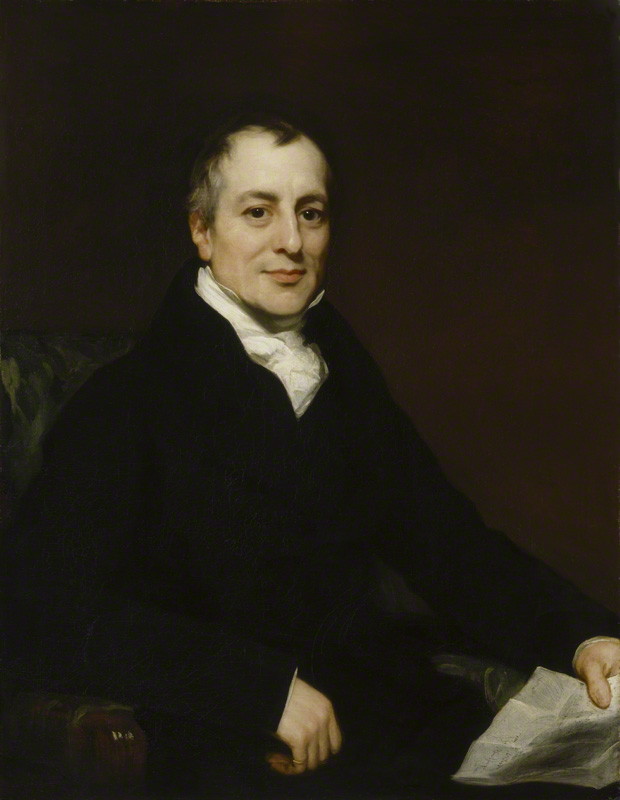Ricardo’s Early Life and Career
David Ricardo (1772–1823) was born in London into a Sephardic Jewish family, whose roots were in Portugal, but who had recently arrived in England from the Dutch Republic. Ricardo’s father was a successful stockbroker.
Ricardo began working with his father at the age of 14. However, when he was 21 Ricardo eloped with a woman from a Quaker background and he himself converted to Unitarianism. As a result, his family broke all connections with him and he was thrown onto his own resources.
Thanks to his family connections, Ricardo was able to set himself up as an independent stockbroker with the help of a prominent London bank. He made a fortune in a very short time. Wealthy to begin with, he was eventually able to retire to a country estate he had purchased in Gloucestershire.
In 1818, Ricardo purchased a seat in the House of Commons (a so-called “rotten borough”) and served as a member of the Whig Party representing the town of Portarlington in County Laois, Ireland.
Ricardo counted James Mill, Jeremy Bentham, and Thomas Malthus among his close personal friends. He carried on an important private correspondence on economics with Malthus (see below).
Ricardo’s Ideas
Ricardo was 27 years old when he first read Adam Smith’s Wealth of Nations (1776) and became intensely interested in the subject of political economy.
However, it was 10 years later, when he was 37, before Ricardo published his first articles on economics in a series of letters to The Morning Chronicle in 1809. He gathered these articles into a book entitled “The High Price of Bullion, a Proof of the Depreciation of Bank Notes” the following year, in 1810 (see “Ricardo’s Principal Books,” below).
In 1815, Ricardo entered into a private correspondence with his friend Malthus, in which he disputed a number of the contentions the latter had made in his own economic publications. Perhaps the most-interesting aspect of this controversy is the question of whether excess demand (“general glut”) can (Ricardo) or cannot (Malthus) be balanced by demand.
In 1817, Ricardo published his magnum opus, On the Principles of Political Economy and Taxation (see below). In this treatise, he basically built upon the foundation laid by Smith in the Wealth of Nations.
Among the most significant of the many topics touched upon by Ricardo in this classic work are a new theory of economic rent, an elaboration of Smith’s labor theory of value, and the first detailed working-out of Smith’s ideas on international trade.
The last-named theory—which James Mill’s son, John Stuart Mill, later called the “theory of comparative advantage”—is often considered to be Ricardo’s single most-important contribution to political economy.
Ricardo’s elaborations of Smith’s ideas provided the foundation for what came to be called “classical economics.” His work can be seen as leading in two different directions, one towards the neo-Classicism of William Stanly Jevons and Alfred Marshall and the other towards the socialism of Karl Marx.
The main reason why Ricardo became popular with many nineteenth-century socialist authors, up to and including Marx, is basically his elaboration of Smith’s labor theory of value. But, of course, Ricardo lived and worked well before the breakthrough to the subjective theory of value by Carl Menger, William Stanley Jevons, and Léon Walras. Therefore, it seems unfair to blame him too harshly for making assumptions that were shared by virtually all the economists of his time.
In 1823, the year of his death, Ricardo wrote a pamphlet in support of the establishment of a central (“national”) bank, which was published posthumously the following year (see below).
In the late nineteenth century, Ricardo’s work was considered to have been superseded by the subjective theory of value and the concept of marginal utility—the twin pillars of “neo-Classical” or “Marshallian” economics.
However, during the 1930s, the Italian economist Piero Sraffa used his own interpretation of Ricardo’s work to critique the neo-Classical consensus. Sraffa’s revival of Ricardo—which came to be known as “neo-Ricardianism”—eventually became a building block of the new, interventionist, interwar consensus, whose leading light was John Maynard Keynes.
Ricardo’s Principal Books
The High Price of Bullion, a Proof of the Depreciation of Bank Notes (1810).
On the Principles of Political Economy and Taxation (1817).
“Plan for the Establishment of a National Bank“ (pamphlet) (1824).
Economic Essays, edited by Edward C.K. Gonner (1923).
The Works and Correspondence of David Ricardo (11 volumes), edited by Piero Sraffa (1951–1973).
Notes on Malthus’s ‘Measure of Value’, edited by Pier Luigi Porta (notes composed in 1823) (1992).
Selected Books on Ricardo
Cremaschi, Sergio, David Ricardo. An Intellectual Biography (2021).
Davis, Timothy, Ricardo’s Macroeconomics: Money, Trade Cycles, and Growth (2005).
Faccarello, Gilbert and Masashi Izumo, The Reception of David Ricardo in Continental Europe and Japan (2014).
Gootzeit, Michael J., David Ricardo (1975).
Henderson, John P. and John B. Davis, The Life and Economics of David Ricardo (1997).
Hollander, Samuel, Economics of David Ricardo (1979).
Hollander, Samuel, Ricardo—The New View (1996).
King, John E., The Anthem Companion to David Ricardo (forthcoming) (2023).
Kurz, Heinz D. and Neri Salvadori, eds., The Elgar Companion to David Ricardo (2015).
Pashkoff, Susan, The Decline of Ricardian Economics: Politics and Economics in Post-Ricardian Theory (out of print) (2003).
Senga, Shigeyoshi, Masatomi Fujimoto, and Taichi Tabuchi, eds., Ricardo and International Trade (2017).
Wood, John Cunningham, David Ricardo: Critical Assessments (1990).
